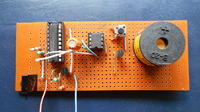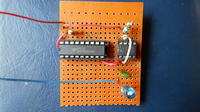DasPreetam
Advanced Member level 4
I think you must learn about the TSOP IR receiver:
The base of your transistor Q1 will hold its output at a low voltage which is wrong as is said on its datasheet.
The TSOP and transistor are turned on by an IR beam. When the burglar blocks the beam then the transistor turns off then the trigger pin 2 of the 555 goes HIGH.
I think you must learn about the 555. It is triggered when its pin 2 goes LOW (when the burglar is gone). Then the buzzers sound and the timer begins. But it will never timeout because pin 2 is held low by transistor Q1.
You are wrong there. The datasheet of the TSOP4038 states that it's output is active LOW i.e. when IR beam is falling on it, it outputs a LOW (0V) to the base of transistor Q1, as a result, Q1 behaves like an open switch and the trigger input is held high.
When the path of IR beam is broke, the receiver outputs HIGH (5V), which turns on the transistor Q1, it now behaves like a closed switch, so the trigger input is pulled low and the timer starts functioning.

